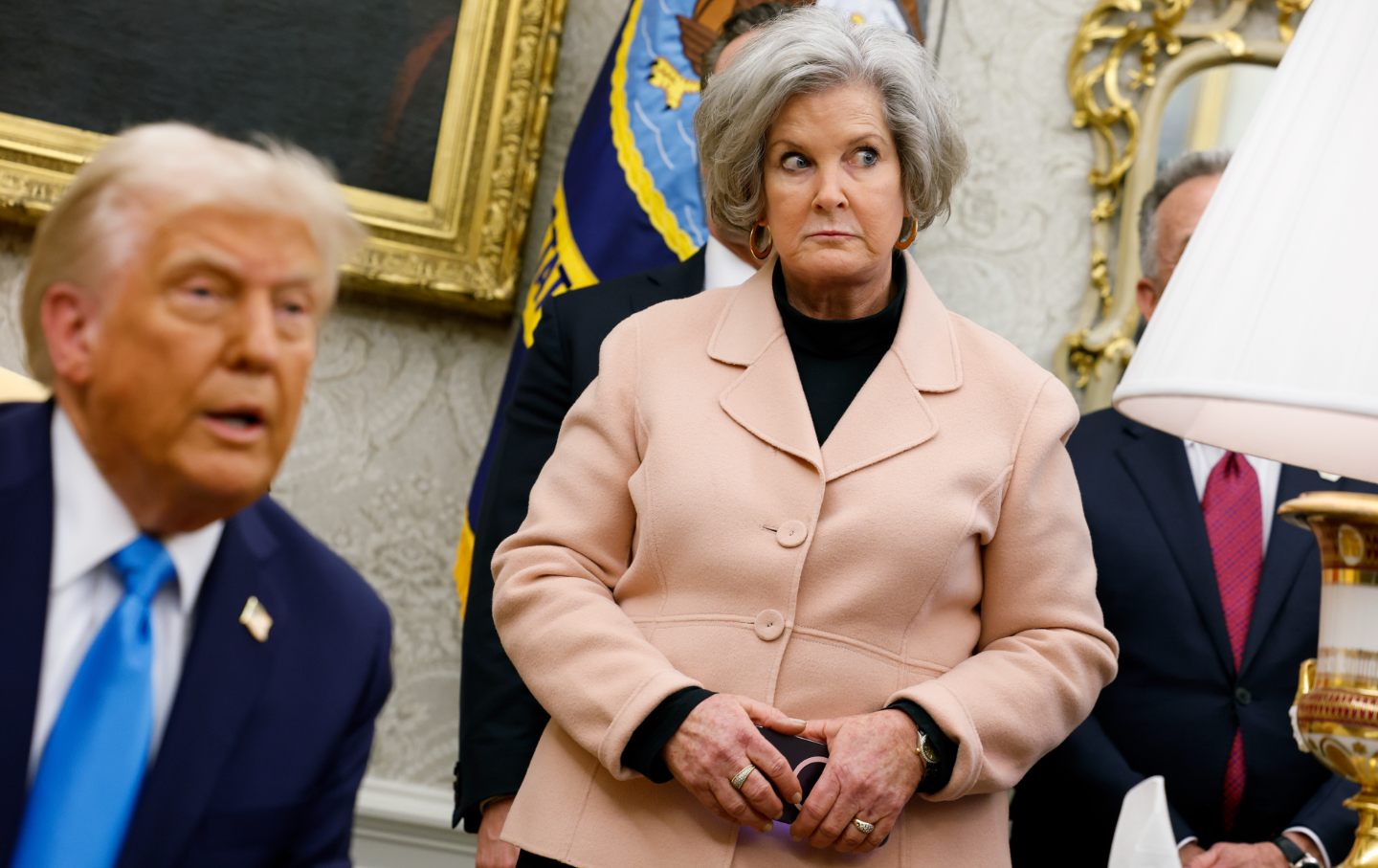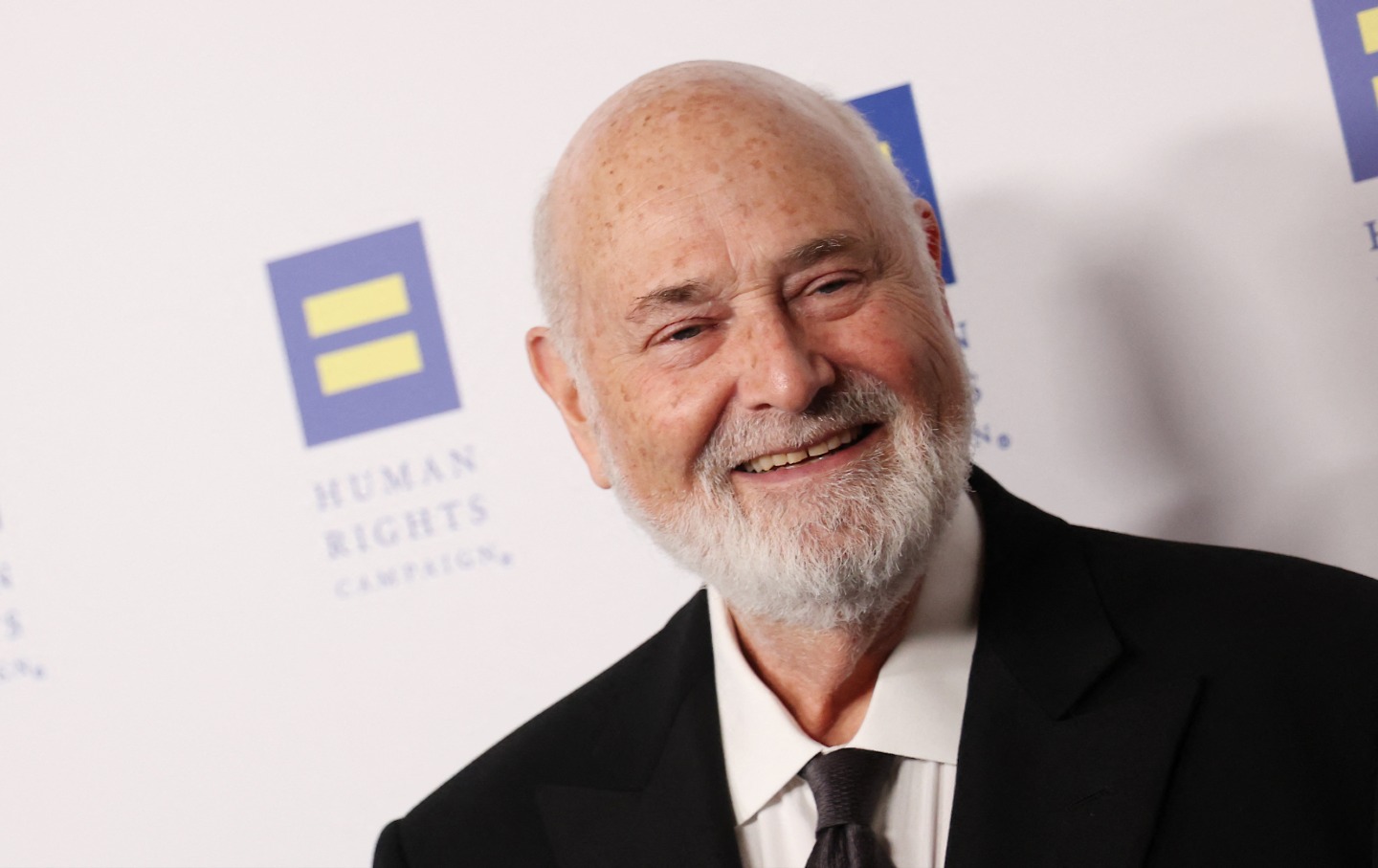Ohio Republicans Want to Rewrite the Rules to Thwart Abortion and LGBTQ Rights
Conservative interest groups are pushing Issue 1, which would require a supermajority for any petition-based constitutional amendments to pass.

A Republican candidate for US Senate in Ohio wearing a voting sticker.
(Drew Angerer / Getty Image)Once synonymous with Midwestern placidity, Ohio has become the epicenter of an unprecedented assault on civil and reproductive rights. Bills banning gender affirming care for LGBTQ youth and trans athletes from participation in women’s sports have been introduced in the statehouse, and House Bill 245 would prohibit drag performances from being held in public.
Now, Republicans in the state are attempting to thwart voters’ ability to amend Ohio’s Constitution. A ballot measure in the August special election could impede a proposed amendment to preserve abortion rights by requiring petition-based amendments to pass with 60 percent of the vote, rather than a simple majority. The proposed measure is “abandoning a fundamental policy that has been part of the Ohio Constitution since 1912,” said Steven H. Steinglass, an expert in Ohio constitutional history. If the measure is approved, it will make passing the abortion rights amendment, introduced by Ohioans for Reproductive Freedom and Ohio Physicians for Reproductive Rights, much more difficult. “These politicians know that their radical views on abortion care can’t win a fair vote, so they’re rigging the system,” said Ohioans for Reproductive Freedom.
These initiatives have been primarily driven by conservative interest groups, with the Ohio-based Christian advocacy organization the Center for Christian Virtue playing an outsize role in shaping Republican policy. Right-wing billionaire Richard Ulhein has spent millions funding the “Save Our Constitution PAC,” which advocates for the ballot measure known as Issue 1. “Our Constitution has been hijacked by special interests and legislators have an opportunity—and duty—to stop it by voting to put the Constitution Protection Amendment on the August ballot,” reads the PAC’s website. Meanwhile, groups like Protect Women Ohio have attempted to connect abortion and trans rights with misleading ads. “If passed, this dangerous initiative would abolish parental notification and consent requirements which protect minor girls from undergoing an abortion or even sex change surgery without her parents’ knowledge or involvement.”
“It’s a horrible case study of how lawlessness builds on lawlessness,” said David Pepper, author of Laboratories of Autocracy and former chairman of the Ohio Democratic Party. As the right entrenches itself in the state, Ohioans have started creating support networks to protect themselves. The Ohio Student Activist Alliance was formed during the amendment debate to “talk to young people and raise awareness about harmful legislation like the gender affirming care ban or the don’t say gay bill,” according to Garrison Bowling, a cofounder. OSAA’s members also submitted testimony in opposition to House Bill 68, which would ban gender affirming care and limit access to puberty blockers.
For Bowling, the attack against the LGBTQ community is personal. Bowling is a gay man and works as a crisis counselor for the Trevor Project. He knows that anti-LGBTQ legislation has a dire impact on queer youth. “I don’t think a lot of people realize how difficult it is to live in a state where the government is trying to outlaw your existence,” said Bowling. According to the Trevor Project, 46 percent of LGBTQ youth and 54 percent of trans youth in Ohio seriously considered suicide in the past year. “Let’s be clear—HB 68 is extreme government overreach and state-sponsored bullying of trans and gender non-conforming Ohioans,” said the American Civil Liberties Union of Ohio.
Bowling wants to motivate young people in Ohio to oppose these far-right attacks. “Ohio has had a youth political gap for years,” Bowling explained. “We are far behind when it comes to youth organizing.” Referencing statewide walkouts in Florida against Governor Ron DeSantis, Bowling said he hopes to build a similar mass movement. The turnout in Ohio for last August’s primary was under 8 percent, but the secretary of state’s office has said that early voting numbers from this year already reflect a nearly fivefold increase. “Ohio deserves better than our current leadership, and it’s time for young people to start fighting back and empowering ourselves,” said Bowling.
Arienne Childrey shares Bowling’s mission of fighting for Ohio’s queer citizenry. A trans woman, Childrey spent her early life in the closet. “For 34 years, I was miserable,” Childrey admitted. “I was active in church, trying to make this secret part of me disappear.” Then, at 34, Childrey came out. Though she lost relatives and colleagues, Childrey said “I haven’t regretted it since.” Childrey now runs Northwest Ohio Trans Advocacy, advocating for “trans rights through allyship, activism and education.”
Childrey, who calls HB 68 “disastrous,” began her career in the local Democratic Party, but left after learning the “vast difference between politics and activism.” Childrey hopes the renewed outrage against LGBTQ people will lead to a new, more militant age of queer activism, hearkening back to Stonewall as a source of inspiration. “I’m not going to play nice with people who want me dead.”
Dr. Anita Somani is an ob-gyn and cochair of the Physician Action Network. The network is a coalition of physicians and medical students who support reproductive rights and gender affirming care for their patients. Though the network was founded in 2017, “access to health care is no better, maybe a little worse than it was,” according to Somani. In some rural areas they’ve “closed practices, denied access to those services.”
Even if these restrictions pass, Somani believes her colleagues will find ways to support their patients. “The people I know who are providing this care will do the best they can to provide the wrap-around care that is permitted,” said Somani.
Despite the preponderance of anti-abortion and anti-trans bills, the demonization isn’t actually popular with Ohio voters. As the August election approaches, it’s clear that Republicans’ plans could backfire. According to a Marist Poll from March, 54 percent of American voters oppose criminalizing gender affirming care for minors, while 58 percent reject drag show restrictions. In Ohio specifically, Suffolk University interviewed 500 voters, and found that 57 percent disagreed with Issue 1. A majority of Ohio voters also support enshrining abortion rights into the state Constitution, according to a poll from Baldwin Wallace University. Turnout this year will be significant. “More than 155,000 Ohioans have already voted in the August 8 special election, with less than three weeks remaining until Election Day,” said Frank LaRose, Ohio secretary of state.
“All of the scientific evidence shows that gender-affirming care is life-affirming care,” said Bowling. Even if the anti-LGBTQ bills pass, Bowling was adamant that his organization will “continue to raise awareness about these issues and give a voice to LGBT youth across Ohio.” The alliance has started confronting lawmakers, asking them about policies and posting the interactions on social media. “They don’t like us very much,” said Bowling, “and that’s a fact we’re very proud of.”
Disobey authoritarians, support The Nation
Over the past year you’ve read Nation writers like Elie Mystal, Kaveh Akbar, John Nichols, Joan Walsh, Bryce Covert, Dave Zirin, Jeet Heer, Michael T. Klare, Katha Pollitt, Amy Littlefield, Gregg Gonsalves, and Sasha Abramsky take on the Trump family’s corruption, set the record straight about Robert F. Kennedy Jr.’s catastrophic Make America Healthy Again movement, survey the fallout and human cost of the DOGE wrecking ball, anticipate the Supreme Court’s dangerous antidemocratic rulings, and amplify successful tactics of resistance on the streets and in Congress.
We publish these stories because when members of our communities are being abducted, household debt is climbing, and AI data centers are causing water and electricity shortages, we have a duty as journalists to do all we can to inform the public.
In 2026, our aim is to do more than ever before—but we need your support to make that happen.
Through December 31, a generous donor will match all donations up to $75,000. That means that your contribution will be doubled, dollar for dollar. If we hit the full match, we’ll be starting 2026 with $150,000 to invest in the stories that impact real people’s lives—the kinds of stories that billionaire-owned, corporate-backed outlets aren’t covering.
With your support, our team will publish major stories that the president and his allies won’t want you to read. We’ll cover the emerging military-tech industrial complex and matters of war, peace, and surveillance, as well as the affordability crisis, hunger, housing, healthcare, the environment, attacks on reproductive rights, and much more. At the same time, we’ll imagine alternatives to Trumpian rule and uplift efforts to create a better world, here and now.
While your gift has twice the impact, I’m asking you to support The Nation with a donation today. You’ll empower the journalists, editors, and fact-checkers best equipped to hold this authoritarian administration to account.
I hope you won’t miss this moment—donate to The Nation today.
Onward,
Katrina vanden Heuvel
Editor and publisher, The Nation
More from The Nation

The Shocking Confessions of Susie Wiles The Shocking Confessions of Susie Wiles
Trump’s chief of staff admits he’s lying about Venezuela—and a lot of other things.

The King of Deportations The King of Deportations
ICE’s illegal tactics and extreme force put immigrants in danger.

How Rob Reiner Tipped the Balance Against Donald Trump How Rob Reiner Tipped the Balance Against Donald Trump
Trump’s crude disdain for the slain filmmaker was undoubtedly rooted in the fact that Reiner so ably used his talents to help dethrone him in 2020.

The Economy Is Flatlining—and So Is Trump The Economy Is Flatlining—and So Is Trump
The president’s usual tricks are no match for a weakening jobs market and persistent inflation.

Trump’s Vile Rob Reiner Comments Show How Much He Has Debased His Office Trump’s Vile Rob Reiner Comments Show How Much He Has Debased His Office
Every day, Trump is saying and doing things that would get most elementary school children suspended.



